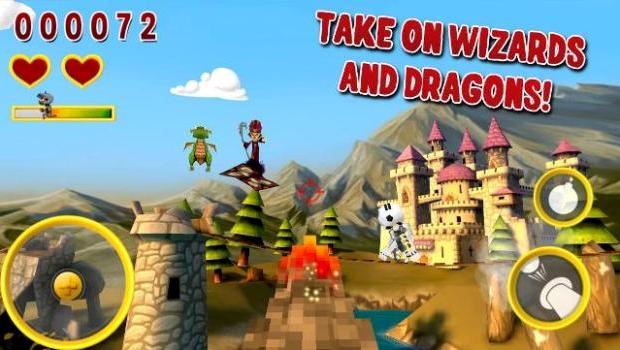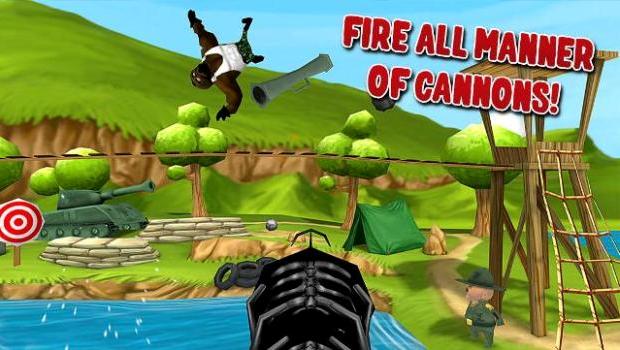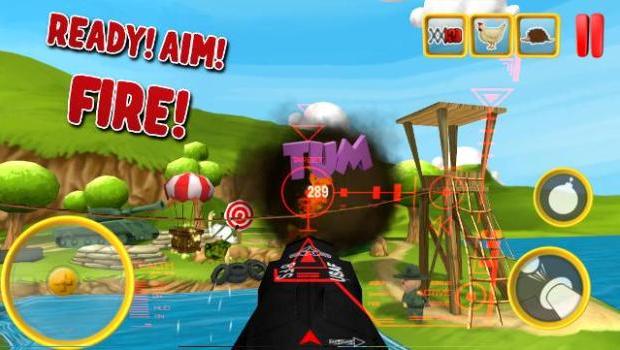If you have ever watched a crazy Japanese gameshow from the 1980s called Takeshi’s Castle, you will probably remember Bridge Ball. The show saw everyday Japanese folk taking on increasingly ridiculous tasks in order to reach the final and win a mystery prize. The games were fiendishly difficult and hardly anyone ever beat the show, and one of the most common tasks, featured almost every week, was Bridge Ball.
In that game, players had to cross a narrow rope bridge safely while being bombarded with balls intended to send them flying off the bridge to the net waiting below. That is more or less how Dodge This! works too. Except this time you control the cannons firing at the contestants, and you have a variety of different weapons in your arsenal in order to make sure you put them down and make them stay down.
Brazilian studio IMGnation have crafted what is at heart a simple title, but one that reveals more features and gets more taxing as you progress. You have three lives and the aim is to survive through waves of enemies crossing the bridge, and last for as long as possible without letting three reach the other side. For every one who gets across, you lose one life. You play from a side-on view and control the aiming reticule of a cannon with either an arcade stick or gyroscopic controls.

There are advantages and disadvantages to both methods. The arcade stick offers greater precision, allowing you to directly drag the reticule to where you want, but the stick covers up a large section of the screen when in use, and it is also easy for your finger to slip outside the range of the stick, meaning that you lose control of the cannon. The gyroscopic controls, on the other hand, lack the precision but are far more fluid and feel much more fun to play. These, however, can easily become un-calibrated as you swing the phone to and fro, but a simple tap of an on-screen button will re-centre the controls.
Once you have mastered the controls, you are ready to take on one of the three stages in the game. You begin with only the army-themed stage, and unlock a pirate and medieval one as you level up (or they can be bought early through in-app purchases). The levels are largely the same in lay-out (a rope bridge suspended between two platforms), but it is the enemies that differ. For instance, the basic army theme has regular soldiers who are killed with one hit, chubby soldiers who take two hits, and lazy soldiers who carry a pillow for protection and can only be defeated with a shot to the head, among others.
There are a large variety of enemies, and the key to successfully surviving waves is to know the best techniques for defeating each and then prioritising who you need to eliminate first. For instance, a brute may take many hits to defeat, but he is slow and won’t threaten your lives for a while, whereas runners are easy to beat with one hit, but can cross the bridge in seconds. Each of the other two levels then also have their own enemies, pirates and knights, who all have their own abilities too (although many remain similar from one stage to the next).

To help in your quest to survive as long as you can, there are coins to collect and extra targets to shoot – which help you level up faster, thereby unlocking new upgrades for you weapons, or which let you purchase extra weapons and special items. These are particularly useful when you find yourself in a bind with a bridge full of enemies – one shot from the Anvil launcher or the Porcupine bomb could wipe out everyone on-screen in one fell swoop. You can of course purchase extra ammo for these by using more real-world money, but all players can earn these fairly easily by re-playing the waves.
That is one of the main problems of Dodge This! – the basic gameplay remains exactly the same throughout the entire game. No matter which of the three levels you play on, you are firing a cannon at the bridge in the same way, using more or less the same tactics. There are no different game modes to attempt; this is it. Ok, there are daily challenges to attempt and mini-goals that help you level up – such as use three homing chickens in one wave, or defeat ten chubby soldiers – but these are mere sidelines and won’t really add any variety to the game, as these are things you would do anyway in a normal playthrough, and not unique tasks.
On top of that problem, there are some massive slow-down issues throughout. When the on-screen action gets a little too busy or hectic, things grind to a halt. Ok, the game does intentionally employ slow-motion effects at times, but the jerky cannon controls and animation that occur during normal gameplay due to slow-down quickly become very irritating.

It must also be said that the graphical presentation lacks a bit of character. Both the stages and models are slightly cartoony, but they are very simple and with a little more effort and attention to detail the visuals might have been a lot more appealing and would have possessed a lot more personality. The same could be said for the audio, which is perfectly serviceable, but does nothing to make it stand out. The presentation is all quite average, and, while it’s certainly not bad, it isn’t something that will really stand out or appeal to gamers.
VERDICT: What Dodge This! does, it does fairly well (slow-down aside), but there is little here that will make it stand out against the swathes of competition. The basic gameplay is fun and immediately accessible, but there is no real depth to the title and the idea of surviving waves is really just an excuse for repetition and a lack of invention. If the waves really differed from one to the next, rather than simply getting more frantic, then there would allow for greater variety but, as it stands – despite the fun that can be had it begin with – Dodge This! is unlikely to keep you busy for long and ultimately offers something of a shallow experience.

DECENT. A 6/10 indicates that, while this game could be much better, it still has a fair amount to offer the player. It might be an interesting title sabotaged by its own ambition, or a game denied greater praise by some questionable design choices. Don’t avoid it outright, but approach it with caution.






